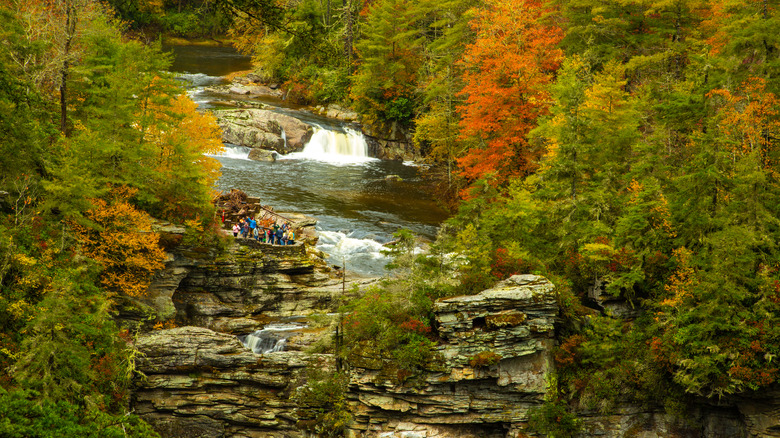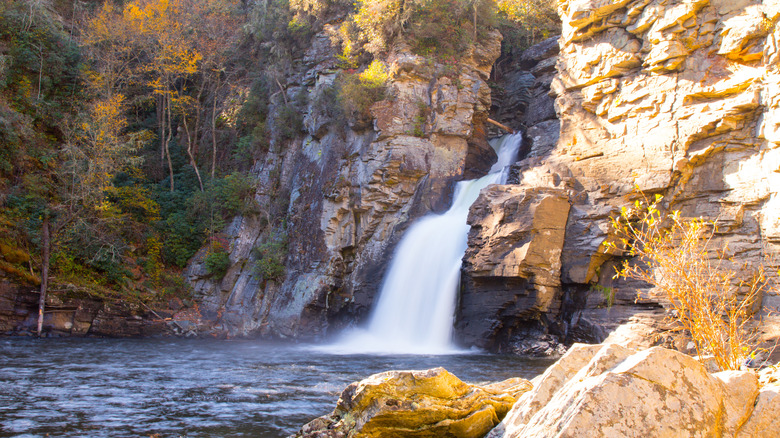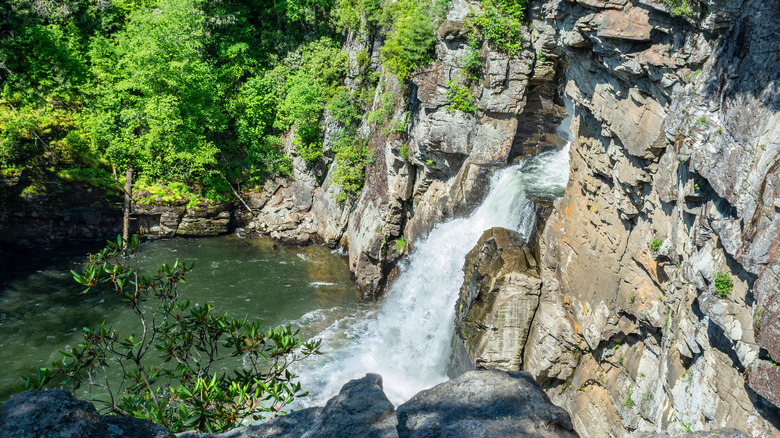Travel Guides Outdoor Adventures Hiking
Kyli Rodriguez-Cayro
While reaching some waterfalls may require a serious trek, North Carolina is home to a picturesque waterfall that hikers can reach in less than 2 miles. Nestled among the mountainous landscape of the state is Linville Falls, one of the most breathtaking waterfalls you can hike to on the East Coast. Linville Falls is located approximately 66 miles from Asheville off of the Blue Ridge Parkway, a scenic driving route that spans through the southern and central Appalachians.
The falls drop about 90 feet, spilling into the 12-mile long Linville Gorge. This deep gorge has been dubbed the “Grand Canyon of the Southern Appalachians.” Rugged cliffs and uniquely-shaped boulders hug the sides of Linville Falls, and a dense forest filled with hemlock, white pine and wildlife surround the cascading waters. Luckily, getting to Linville Falls is pretty simple: There are two main trails to choose from that will lead you to this natural wonder, with each route boasting several lovely lookout points along the way. The Erwins View Trail will lead you to unparalleled views of the falls and the Linville Gorge, while the Linville Gorge Trails offers a tougher hike with a different vantage point of the falls.
The Erwins View Trail

Bob Pool/Shutterstock
The Erwins View Trail is a moderate, out-and-back route that is 1.6 miles round-trip featuring four different observation areas along the way. Each provides a different scenic view of the historic waterfalls, and the surrounding foliage. A half-mile from the Linville Falls Visitor Center, hikers will reach the first overlook. Here, you can catch a glimpse of where the Linville River spills over the upper falls, and the narrow canyon that leads to the steep lower falls. Around .7 miles into the hike, you’ll find the Chimney View overlook, which can be accessed by taking a steep — but short — side path. This dramatic bluff offers spectacular views of the cascading lower Linville Falls for the first time along the trail, and is aptly named after the rock outcroppings that resemble a chimney in shape.
The third lookout point is the Gorge View Overlook — an observation area where you can gaze at the Linville River as it winds through the Linville Gorge. Lastly, at the end of the trail, you’ll reach the ultimate vista of the hike: Erwin’s View Overlook. Here, visitors can enjoy sweeping views of both the upper and lower falls, as well as the spanning Linville Gorge.
Linville Gorge Trail

Jess Whitney/Shutterstock
Experienced hikers seeking a more challenging route will want to hike the Linville Gorge Trail. This trail begins at the visitor center, and splits into two separate routes at around .2 miles into the hike. The left fork leads hikers deeper into the gorge and ultimately to the base of Linville Falls, where you’ll have up-close views of the massive boulders and a large pool. While you can relax, explore, and picnic at the falls, it’s important to note that swimming is prohibited due to swift, dangerous currents. If you chose the trail to the right (at the .2-mile point), you’ll eventually end up at the Plunge Basin Overlook — a picture-worthy vista providing expansive views of the lower falls and unique, rock formations.
You can visit this beautiful creation of nature in the spring and summer to see blooming flora; in the fall to observe the leaves changing color; or even in the winter when it’s more serene and less crowded. Whenever you choose to make the trek to Linville Falls, you’re sure to have a truly special Blue Ridge Parkway experience.

